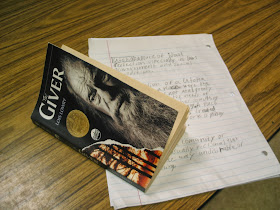 |
Objective: Student will begin reading The Giver, reflecting on character development, setting, symbolism, and writer intent.
So far we've:
-Read Chapters 1-4 of The Giver out loud, pausing to reflect on setting, foreshadowing, and charecter development
-Compiled a list of memories, the sensory details associated with those memorys, and the emotions they evoke
-Defined "utopia" and "dystopia" and reflected on those definitions
-Wrote a piece of creative nonfiction in the style of Lois Lowry
-Discussed symbolism and the role of symbols in The Giver
K's reflection on his idea of utopia:
"My vision of utopia would be a place where the government is not all greedy and listens to the needs of the people and does something about what is wrong--a place where everyone is treated equally and everyone is giving to those in need."
Washington State Standards Covered:
Reading:
-Students are able to build and integrate new vocabulary
-Students are able to apply word recognition skills to gain fluency. Students are able to read grade level texts aloud smoothly and expressively.
-Students are able to demonstrate evidence of reading comprehension through their understanding of theme, main, and supporting ideas.
-Students are able to apply prior knowledge to a reading, connecting the text to current or cultural events.
-Students are able to predict and infer, citing textual examples to support their inferences.
-Students are able to use comprehension monitoring strategies, including generating and answering questions and creating a graphic organizer
-Students are able to summarize of the main ideas in a text.
-Students are able to understand time and sequence in a text (for example, explaining foreshadowing in a work of fiction or steps in nonfiction)
-Students are able to identify the point of view used (first, third, or omniscient point of view) in a story and identify themes in the story. Students are familiar with story elements (character, setting, conflict)
-Students understand the functions of literary devices, recognizing previously taught literary devices (simile, personification, humor, metaphor, idiom, imagery, exaggeration, irony, sarcasm, and dialogue)
-Students are able to analyze how an author’s style of writing, including language choice, achieves the author’s purpose and influences the author's target audience.
-Students are able to think critically and analyze author’s use of language, style, purpose, and perspective in informational and literary text, verifying facts for bias and accuracy.
Writing:
-Students know how to write in a variety of modes including writing to analyze, writing to learn, and writing to entertain.
-Students can write in many genres, tracking the genres they've used in a writing log.
-Students can write in many genres, tracking the genres they've used in a writing log.
-Students analyze ideas, selects a manageable topic, and elaborates using specific, relevant details and/or examples.
-Students chose appropriate voice and tone for their writing genre and audience
-Students display a rich vocabulary and uses both literary and poetic devices to enrich their writing
-Students vary sentence structure, length, and cadence.
-Students apply capitalization, spelling, and usage conventions, using references to verify the correctness of their work
-Students display a rich vocabulary and uses both literary and poetic devices to enrich their writing
-Students vary sentence structure, length, and cadence.
-Students apply capitalization, spelling, and usage conventions, using references to verify the correctness of their work

No comments:
Post a Comment